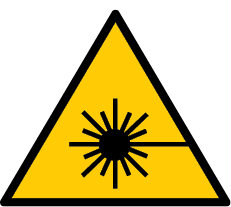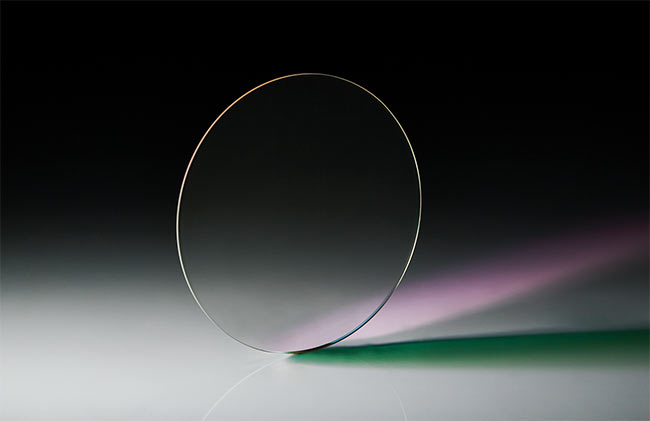
Durable Optical Coatings Help to Advance Laser Safety
 Today, lasers can be found in a multitude of applications ranging from laser pointers for classroom instruction to medical instruments for eye and cosmetic surgery. Lasers are also used for research, materials processing, defense, and flight safety.
Today, lasers can be found in a multitude of applications ranging from laser pointers for classroom instruction to medical instruments for eye and cosmetic surgery. Lasers are also used for research, materials processing, defense, and flight safety.
Because of the high power densities that lasers achieve, they pose a serious
risk to eyes and skin. Depending on variables such as wavelength, continuous-wave or pulsed operation, and direct or diffused exposure, lasers can cause permanent ocular injury or can vaporize skin tissue. The focusing properties of the human eye can significantly increase the impact of irradiance entering the retina, which makes eye safety a critically important practice for laser users. Lasers are categorized into several hazard classes, depending on their power limits: 2M, 3R, 3B, and 4.

Interference coatings enable safety glasses that offer broad visible light transmission with attenuation at selective wavelengths. While fused silica is an optimal choice for the starting surface, borosilicate glass can provide the same desired properties at a much lower price. Courtesy of Hind High Vacuum Co. Pvt. Ltd.
Laser safety glasses are available with various specifications to match factors such as the laser’s operating wavelength and power and the user’s environment. These specifications define key attributes, such as optical density (OD), visible light transmission (VLT), and color vision.
OD defines how much safety glasses attenuate laser wavelengths. VLT measures the amount of light the eyeglasses transmit in relation to the spectral sensitivity of the eye. At lower levels of transmission, the eye response shifts to lower wavelengths and goes into a night-vision mode with restricted color vision. Reduced color vision can lead to situations in which warning signs or nearby equipment may not be easily perceived.
The three main types of filters used in the production of laser safety glasses are polycarbonate, absorption glass, and
thin-film-coated filters. Polycarbonate filters are lightweight and impact-resistant but are less durable given their construction. In addition, polycarbonate filters
exhibit lower OD and VLT, which restricts their use to laser applications characterized by low to middle power densities.
Absorption glass filters typically allow more visible light to be transmitted through the lens compared to polycarbonate filters, making them more suited for use with mid- to high-power-density lasers. In instances where multiple laser wavelengths need attenuation, two or more absorption glass filters can be laminated together. This makes them less robust in high-powered applications due to the possibility of delamination, or breakage, in the mounting caused by mechanical stress.
Applications involving high-power lasers require glasses that offer high VLT and high attenuation. Thin-film interference coatings best suit these requirements. Attenuation at multiple wavelengths can also be achieved while preserving other advantages. Thin-film deposition methods are typically costlier compared to polycarbonate and absorption glass filters. But e-beam deposition methods with ion assistance offer a good balance between cost and performance.
Interference coatings are produced by depositing a predetermined series of alternating layers of high- and low-index materials to meet the desired spectral performance. The more complex the per-
formance requirement, the more stringent the coating parameters must be. The type of coatings required for laser safety glasses are called reflective notch filters, which reflect a laser’s wavelength while transmitting the rest of the spectrum. For a coating to maintain performance over more than the normal incidence, it needs to have a high refractive index. A series of thick high-index and thin low-index layers helps to minimize shift in performance caused by angle. An antireflection coating is applied to the back side of the glasses to minimize secondary reflections.
Fused silica glass is an optimal choice for the starting surface, but borosilicate glass can provide the same desired properties at a much lower price. Borosilicate glass has low defects, such as pitting, low internal absorption, and a uniform refractive index. Sleeks on the glass must be avoided during manufacturing because they will cause laser light to scatter. Coating materials with very low absorption are necessary to achieve a high laser damage threshold as well as good VLT. Additionally, low internal stress is key. Tantalum pentoxide (Ta2O5) and silicon dioxide (SiO2) are widely chosen for high- and low-index materials, respectively, given their low intrinsic absorption and stress.
Extreme control of the deposition process during each coating cycle is required to maintain the properties of each layer. Ion assistance during this process promotes high density of layers to achieve bulk-material-like properties for the high- and low-index materials. High-density layers ensure that the coatings can withstand long-term changes in environmental conditions such as temperature and humidity. An advantage of thin-film-based filters is their ability to attenuate a narrow wavelength range to gain high VLT. Steep slopes of the transition region from reflection to transmission further aid in improving VLT while maximizing manufacturing tolerances. Spectrophotometers with high photometric linearity and accuracy are required to precisely measure and qualify the characteristics of the coating manufactured.
E-beam ion-assisted deposition manufacturing methods provide a favorable combination of durability and lower cost of operation compared to other coating techniques, and they offer a versatile solution for laser safety glasses. Future challenges include producing coatings capable of protecting against even higher optical densities for use with extremely high-power lasers. Another important goal to achieve is the capability to deposit coatings evenly on curved eyepieces to maintain their performance over wider angles of incidence.
Meet the author
Ramakrishna Siddam is assistant general
manager for the Thin Films and Optics division at Hind High Vacuum Co. Pvt. Ltd. He has over 10 years of experience in developing thin-film products for scientific, defense, and space applications; email: [email protected].
/Buyers_Guide/HHV_Advanced_Technologies_Pvt_Ltd_Thin_Films_/c23383